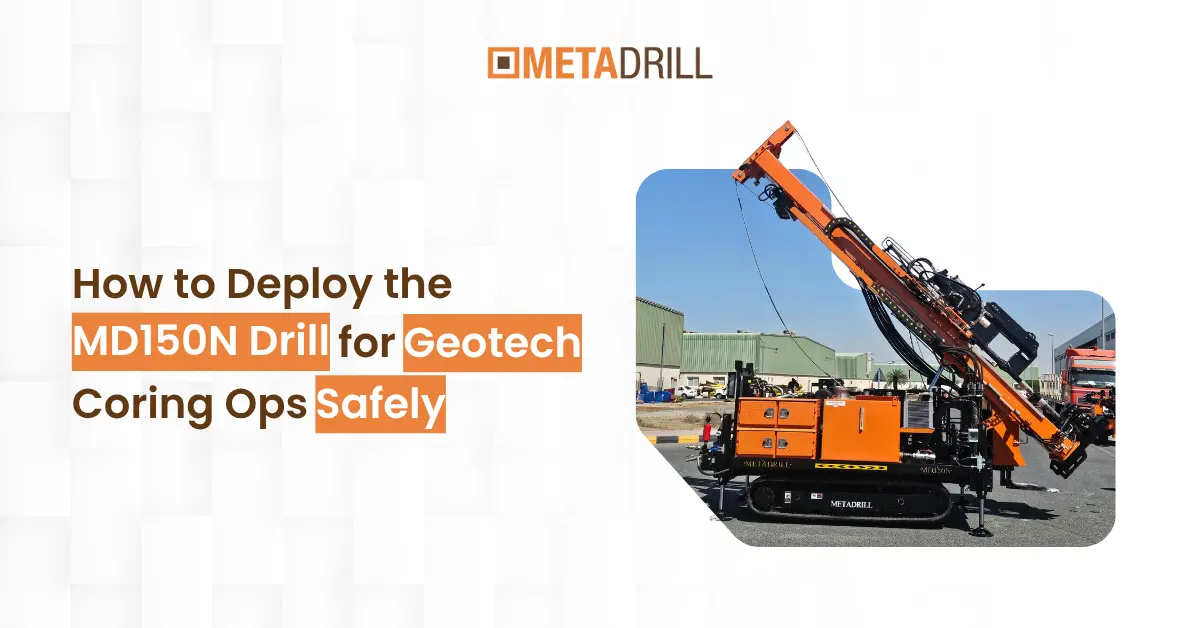
Deploy the MD150N with a safety-first playbook: standards-led setup, clean exclusion zones, disciplined rod handling, and documented sampling. Do that, and the MD150N drilling rig turns small urban pads into predictable core runs. This guide walks your crew through pre-mobilization, site setup, coring execution, and close-out, step by step. EN 16228 rig safety overview.
Early context: Struck-by hazards remain a top killer in construction, and about 75% of struck-by fatalities involve heavy equipment. Strong zones, signals, and controls save lives.
Build the Safety Frame Around the Machine
Anchor to Standards
EN 16228: guards, interlocks, emergency stops, and stability checks for every drill rig deployment.
ISO 22475-1: sampling principles so the core you collect on MetaDrill geotechnical drilling jobs is defensible, liner choice, preservation, and logging.
Why MD150N fits the brief
The MD150N drilling rig is a compact member of MetaDrill drilling rigs built for tight pads and quick rig-up. Its scale favors urban access while still delivering the control you need for clean, short core runs, ideal for foundation checks.
Pre-Mobilization: Make Problems Impossible to Miss
Paperwork and people
Method statement + risk assessment: include standards, utilities clearance, exclusion zones, and stop-work authority.
Crew roles: supervisor (permits), lead driller (panel), offsider (handling drilling tools), HSE (audits). Use repeat-back comms on critical steps.
MD150N pre-checks
Verify guards/interlocks (feed, rotation) and test all E-stops.
Inspect hydraulic lines; fit dust caps; clean breathers.
Calibrate RPM/torque/pressure sensors; record certificates in the rig file.
Confirm core barrels, liners, and shoe sets match the expected formation.
Site Setup: Turn a Small Pad Into a Safe Pad
Stage the work, then the hardware
Exclusion zones: paint the rotation envelope; cone off the rod-handling corridor.
Housekeeping: mats, drip trays, routed hoses; lighting for night work.
Sightlines: mount cameras or mirrors to watch the rod handler and returns.
Signals: one radio channel; hand signals posted at the panel, no mixed commands on MetaDrill geotechnical drilling shifts.
Tooling at arm’s reach
Stage alternative bit crowns, spare shoe sets, and a dummy joint. Keeping drilling tools in sequence reduces idle minutes and avoids unsafe reach-ins.
Execute the Core Run: Smooth, Guarded, Documented
Rotation, feed, and returns
Rotation: start within the bit spec; no “free-spinning” near hands.
Feed: maintain contact, avoid chatter; adjust when returns change.
Returns: watch for fines or color change; adapt flushing before recovery drops.
Rod handling without drama
Use mechanical aids; never free-hand near rotating steel.
Apply thread compound sparingly; torque to spec; check for galling.
Keep tongs, dies, and slips clean, grit turns them into pinch hazards on any drill rig.
Sampling discipline (ISO 22475-1)
Confirm liner ID and fit; label core boxes before the run.
Record recovery, RQD, refusals, and groundwater observations as you go.
Photograph boxes with visible IDs; maintain chain-of-custody, this is where MetaDrill drilling rigs earn trust.
Common Pit Stops: Fix It Fast, Fix It Safely
If penetration stalls
Downshift RPM, add weight carefully, or change crown; don’t “muscle through.”
Check fluid properties; add loss-control materials if seepage appears.
If vibration spikes
Reduce RPM, tune feed, inspect bit wear, and verify rod straightness.
Replace worn dies; polished jaws slip and overheat rods, damaging drilling tools.
If recovery drops
Shorten runs; verify shoe/liner pairing; clean the barrel.
Recut the face and reset parameters before resuming.
Close-Out: Leave the Next Shift Better Than You Found It
End-of-shift routine
Wash and inspect drilling tools; retire worn crowns early.
Reconcile rods/couplings; spin a dummy joint to feel for thread damage.
Update logs; back up photos and data; stage tomorrow’s kit.
Quick panel test: E-stops, alarms, and interlocks, again.
Hand injuries are persistent and costly; many stem from pinch points and poor glove discipline. Reinforce glove policy and tooling condition at every brief.
Micro-Checklist (Post on the Panel)
MD150N Go/No-Go
Guards closed, interlocks live
E-stops tested
Sensor readings verified
Exclusion zones marked, comms checked
Tooling staged, alternatives ready
Core Run Discipline
Hands clear, aids only
Rotation/feed within limits
Returns monitored, adjustments logged
Samples labelled, photos taken
You can also check: Drill Bits 101: PCD, TCI, Drag - When Each Bit Works Best 2025
Conclusion: Safe Deployment Is a System, Not a Speech
Treat the MD150N like a system: standards-led controls, visible zones, disciplined handling, and documented sampling. Do that, and the MD150N drilling rig will deliver clean boxes on small pads with less drama. With MetaDrill drilling rigs configured for access and control, and crews who respect the plan, your drill rig stays productive, your drilling tools stay healthy, and MetaDrill geotechnical drilling keeps site risk low while core quality stays high.
Question to the public:
Deploy the MD150N safely in UAE: EN 16228 setup, clean zones, disciplined rod handling, ISO 22475-1 sampling. Turn small urban pads into predictable cores.